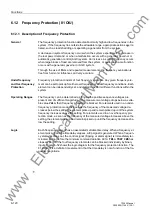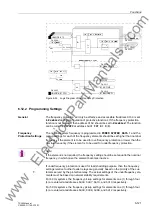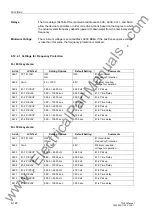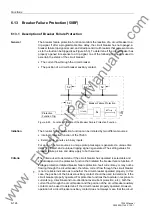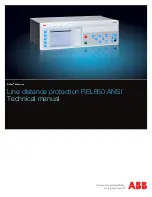
Functions
6-134
7SJ63 Manual
C53000-G1140-C120-1
If the circuit breaker is not ready for operation when the dead time elapses, the dead
time can be extended (see setting of dress
). If during this extended dead time
period the circuit breaker mechanism indicates, via the
binary input, that it is
ready for another operation, a reclose command is initiated. However, if after the dead
time the additional monitoring delay time elapses before the
binary input picks
up, dynamic blocking is initiated and any further operation of the circuit breaker from
the automatic reclosing system is prohibited.
2nd Method: Not applicable for version 7SJ61**–A**– and 7SJ61**–M**
An alternative circuit breaker monitoring method involves a separate time delay inter-
val and binary input (FNo.
“
!7:$,7
”). This binary input indicates that the
circuit breaker is not ready for operation, as opposed to indicating that the circuit
breaker is ready. At the end of the dead time interval, if the
binary input is picked
up, a closing command time delay is initiated (see setting dress
0$;,QKLELW
7,0(
). If the
binary input drops out prior to the elapse of the closing command
time delay, reclosing is performed. However, if the closing command delay time elaps-
es before the
binary input drops out, dynamic blocking is initiated and further op-
eration of the circuit breaker by the automatic reclosing system is blocked.
Load Side Fuse
Protection and
Zone Sequence
Coordination
Not applicable for version 7SJ61**–**A**– and 7SJ61**–**M**:
Figure 6-58 shows an example of how zone sequencing and protection of load side
fuses is possible in a radial distribution system. Consider the relays protecting Feeder
#3 and the busbar. Assume that the relay protecting Feeder #3 is programmed for one
reclosing attempt and that the busbar relay does not utilize reclosing.
For fault F1 at Tap Line #2, the 50-2 elements associated with both the Feeder #3 re-
lay and the busbar relay pickup. The time delay of the 50-2 element protecting Feeder
#3 is set so that the Feeder #3 circuit breaker will clear the fault before the fuse at Tap
Line #2 is damaged. After the first reclosing attempt, if the fault was cleared, normal
service is restored to all customers (including the customers served by Tap Line #2).
If after the first reclosing attempt, the fault continues to exist, the 50-2 element at Feed-
er #3 is blocked, and the fuse operates to clear the fault. If the fuse fails to clear the
fault, then the 50-1 element protecting Feeder #3 will initiate a delayed trip signal (0.4
seconds), thus serving as backup protection for the fuse.
Assume protection requirement require that the 50-2 element at the busbar relay be
set with a delay of 0.4 seconds as well. When the fault first appears at F1, the 50-2
element at the bus relay picks up, but drops out when the 50-2 element at Feeder #3
trips the circuit breaker. Upon reclosing, if the fault still remains, the 50-2 element as-
sociated with the bus relay picks up again, however, the fuse operates to clear the
fault, thus resulting in a drop out of the 50-2 element at the busbar relay. Had the fault
been on Feeder #3, however, the 50-2 element associated with the busbar relay would
have initiated a trip (simultaneously with the trip initiated by the Feeder #3 50-1 ele-
ment) after reclosing had occurred. All three feeders supplied by the bus would have
been cut off from the incoming supply for a fault that should have locked out Feeder
#3 only.
To prevent this from happening, zone sequencing is switched on at the bus relay (See
AR setting dress 7140). With zone sequencing in operation, the bus relay counts the
number of times a fault is interrupted. For the first fault, the 50-2 element at the bus is
allowed to trip. If the fault is at F1 or on Feeder #3, the 50-2 element protecting Feeder
#3 will initiate a high speed trip, thus causing the 50-2 element at the bus relay to drop
out.
For the second fault, the 50-2 element at the bus relay must be blocked because the
50-2 element at Feeder #3 is blocked, and a permanent fault on Feeder #3 could result
www
. ElectricalPartManuals
. com
Содержание siprotec 7SJ63
Страница 16: ...xiv 7SJ63 Instruction Manual C53000 G1140 C120 1 w w w E l e c t r i c a l P a r t M a n u a l s c o m ...
Страница 28: ...Introduction 1 12 7SJ63 Manual C53000 G1140 C120 1 w w w E l e c t r i c a l P a r t M a n u a l s c o m ...
Страница 112: ...SIPROTEC 4 Devices 4 38 7SJ63 Manual C53000 G1140 C120 1 w w w E l e c t r i c a l P a r t M a n u a l s c o m ...
Страница 346: ...Functions 6 182 7SJ63 Manual C53000 G1140 C120 1 w w w E l e c t r i c a l P a r t M a n u a l s c o m ...
Страница 494: ...Technical Data 10 48 7SJ63 Manual C53000 G1140 C120 1 w w w E l e c t r i c a l P a r t M a n u a l s c o m ...
Страница 604: ...Index Index 6 7SJ63 Instruction Manual C53000 G1140 C120 1 w w w E l e c t r i c a l P a r t M a n u a l s c o m ...

